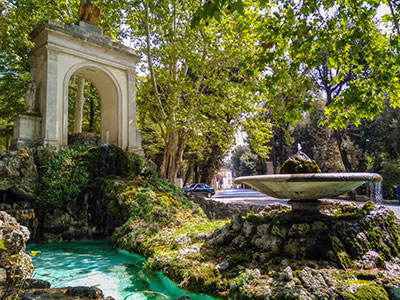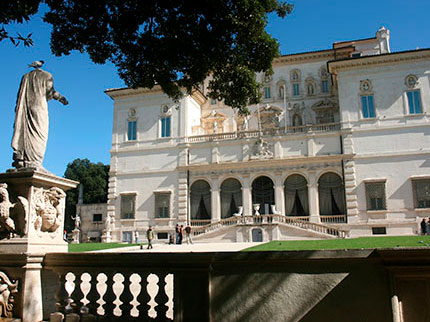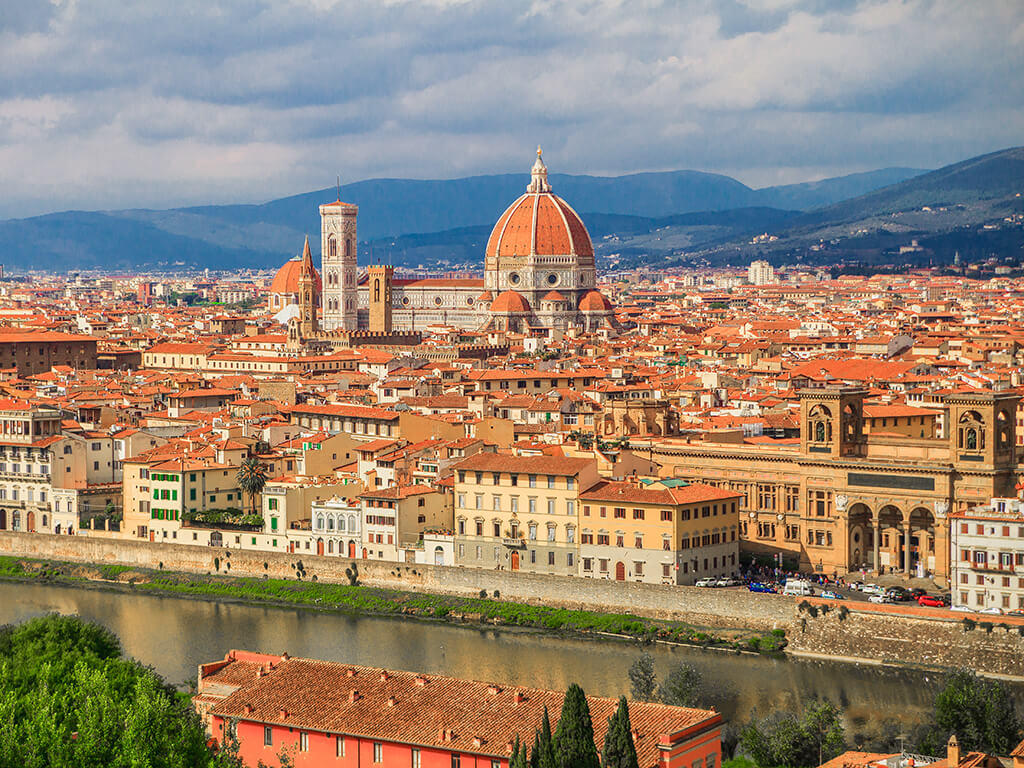Villa Borghese is the largest public park in central Rome, and this charming and elegant green space offers peace and quiet in an otherwise bustling city. The heart-shaped complex dominated by pine trees was designed in the 17th century by Cardinal Scipione Borghese, a nephew of Pope Paul V. He commissioned fountains by Giovanni Fontana and sculptures by Pietro Bernini, which are just some of the monuments in the park. Villa Borghese is most famous for its gallery and museum which together safeguard masterpieces of Italian art. It became state-owned in 1901 and its gardens are open to the public – it’s a popular spot for bicycle rides and other activities. You’ll find an amphitheatre, an artificial lake and a zoo (the Bioparco), making it a great choice for a family day out.

Villa Borghese park: Rome’s biggest green space
The amphitheatre is nestled among trees in Piazza di Siena and nearby is the Casina di Raffaello, said to have been owned by the Italian master Raphael. Villa Borghese has numerous fountains and statues – watch out for Byron, Goethe and Victor Hugo during your stroll.
The Giardino del Lago, in the centre of Villa Borghese, is a garden with an artificial lake where you can hire boats, and there’s an Ionic temple that was raised in honour of the god of health. The pretty Fontana dei Fauni (Fountain of the Fauns) is a fine example of Art Nouveau.
Visiting the Borghese Museum and Gallery
The Borghese Museum and Gallery may be small in comparison to Villa Borghese but they nonetheless house great works by world-famous artists including Bernini, Canova, Raphael and Caravaggio. The collection was brought together by Cardinal Scipione Borghese (1579-1633). Most pieces were sold to the Louvre in 1807 under pressure by Napoleon, whose sister married Prince Camilo Borghese. When the Italian state acquired ownership of the rest in 1902, it became the custodian of one of the most important art collections in Rome.
The pieces are housed in what was the casino or summer house at Villa Borghese. The lower floor has sculptures and classical antiquities, while the upper floor is a treasure trove of paintings. One of the jewels in the collection has to be the sculpture of Paulina Borghese, immortalised by Antonio Canova as though she were Venus. The writer Terenci Moix paid tribute to the work in his novel Venus Bonaparte.

Masterpieces by Bernini, Correggio and Titian
Scipione Borghese was Bernini’s first patron and a huge aficionado of Caravaggio. Both artists are heavily present in the museum alongside other painters such as Rubens, José de Ribera, Bronzino and Barocci.
Canova’s effigy of Paulina Borghese is not the only treasure in the Borghese Gallery. Bernini’s David depicts the underdog just about to throw his stone at Goliath, and his Apollo and Daphne shows the latter fleeing from Apollo and the start of her transformation into a laurel tree. The upper floor has exceptional paintings including Raphael’s The Deposition (1507), Correggio’s Danaë (1530), Antonello da Messina’s Portrait of a Man (1475) and Titian’s Sacred and Profane Love (1514).
If that’s not enough, the collection also boasts Domenichino’s Archery Contest of Diana and Her Nymphs, Rubens’ Pity, Lucas Cranach’s Cupid complaining to Venus and José de Ribera’s Judgment of Solomon.
The Borghese Museum and Gallery is a small yet popular tourist attraction and advance booking is essential. Otherwise, you’ll find yourself queueing with no guarantee of getting in. It’s best to book ahead to avoid disappointment.
El catálogo de obras maestras incluye también ‘La cacería de Diana’, de Domenichino; ‘La Piedad’, de Rubens; ‘Venus y Amor’, de Lucas Cranach, o ‘El juicio de Salomón’, de José de Ribera.
Hay que recordar que Scipione Borghese fue el primer mecenas de Bernini y un apasionado de la obra de Caravaggio, por lo que ambos artistas están muy bien representados en el museo, además de otros pintores, como Rubens, José de Ribera, Bronzino o Barocci.
Debido a que el museo es pequeño y hay mucha demanda de visitas, la entrada a la Galleria e Museo de la Villa Borghese sólo se puede hacer con reserva previa. En caso contrario, hay que hacer cola e intentar conseguir una entrada de última hora. Así que no lo olvides. Tenlo en cuenta para evitar contratiempos.










































































